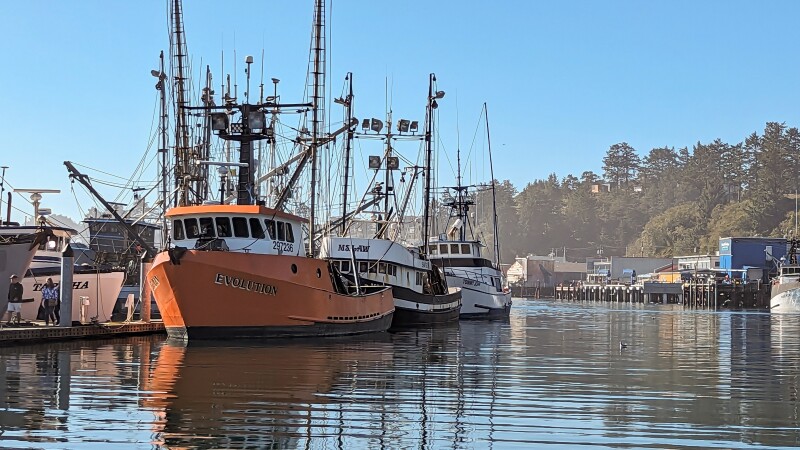Oregon’s fishing scene in 2023 was a bit of a mixed bag. While the state’s commercial fishing industry landed 301 million pounds of seafood, up from the previous year, the total revenue didn't quite hit the high notes of the past few years. The amount of crab harvested nearly doubled compared to 2022, but low prices kept the revenue from making this season something special for the fishermen. Salmon landings took a hit, and the pink shrimp market saw a price drop despite better landings. Overall, it was a year of contrasts, with some fisheries thriving and others struggling.
The report shared by the State of Oregon Employment Department examined individual fisheries and employment in each state county. The industry landed a total of 301 million pounds, which was worth $178 million in 2023. Though it was more pounds than in 2022, it was below the average landings and revenue from 2018 to 2022, which was 319 million pounds worth $189 million.
Crab harvests in 2023 were 37.2 million pounds versus 4.9 million pounds the year before. Typically, the state’s crab season begins in December. However, the season didn’t fully open until Feb 1, 2023, making the 2022 crab harvest drastically lower than the historical trends. The 2023 harvest was twice as large as the five-year average of 18.3 million pounds. The year's total revenue sat at $104 million due to the low crab prices. Dungeness crab's average landed price per pound was $2.80 in 2023, the lowest seen since 2013’s $2.74 per pound.
Salmon landings significantly dropped 18% in 2023, totaling 1.7 million pounds. This was more than the five-year average, which was 1.4 million pounds. The average price also dropped, leading to a decrease in total landed value of 32%, totaling $5.2 million. The U.S. Secretary of Commerce issued a disaster declaration for the 2023 Oregon ocean troll salmon fishery due to the long-term trend of low levels of salmon harvests.
In 2023, the state’s pink shrimp harvest reached 44 million pounds, marking a 7% increase from 2022 and surpassing the average of the past five years. However, shrimp prices fell to 42 cents per pound, the lowest since 2010. Despite the higher catch, overall revenue remained steady at $18.7 million, like the previous year. Oregon’s pink shrimp fishery has been certified as sustainable by the Marine Stewardship Council since 2007 and was reassessed as sustainable in 2011.
The amount of whiting landed in Oregon dropped for the fourth consecutive year, falling 3.7% in 2023 to 164 million pounds. Despite making up 60% of the state's wild seafood by weight, whiting's low market value kept its overall landed value at just $14.9 million. Much of the state’s whiting is processed into surimi for imitation crab meat, with the leftover carcasses used for fishmeal.
Groundfish landings, excluding Pacific whiting, also took a hit, declining 13% in value to $26.3 million in 2023. The total catch weighed in at 47.7 million pounds, down 4.7% from the previous year, and the average price dropped to 55 cents per pound.
Albacore tuna harvests hit their lowest level since the early 2000s, with only 2.45 million pounds landed in 2023. Prices fell to an average of $1.44 per pound, resulting in a total revenue of $3.5 million.
Smaller fisheries saw some shifts as well. Pacific halibut landings brought in $1.6 million from nearly 269,000 pounds, while razor clam harvests plummeted from a 2022 peak to just 18,000 pounds in 2023, valued at $235,000.
Employment within Oregon’s commercial fishing industry
An estimated 1212 commercial fishermen, excluding tribal fishing, worked in Oregon annually in 2023. This was a slight decrease from the number of fishermen in 2022. The average number of fishermen had been about 100 to 200 higher before the COVID-19 pandemic. Fishing employment has often peaked in the summer; however, the past couple of years have shown a gloomy summer season but a peak in the spring.
Based on where landings occurred, the five coastal counties of Clatsop, Coos, Curry, Lincoln, and Tillamook had 95% of the total employment. Crab, salmon, and pink shrimp are the most important fisheries for direct employment. In addition to employment, the number of fishing vessels has also declined from historic highs. Over the past seven years, there has been a period of declining numbers of fishing vessels. In 2023, there were 786 vessels, with at least one landing in 2023, down from the 861 vessels in 2023.
In addition to the direct employment within fisheries, commercial fishing provides the resource for seafood processors. Records show that 39 processors in Oregon had employees in 2023, which made about 1092 jobs for the year. This is the highest number of processors in recent history, surpassing the previous high of 36 in 2019.







